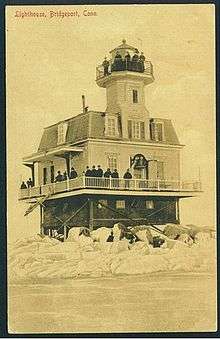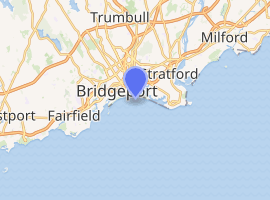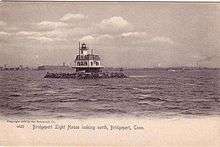Bridgeport Harbor Light
The Bridgeport Harbor Light, later the Bridgeport Harbor Lighthouse, was a lighthouse in Bridgeport, Connecticut, United States. It is located on the west side of the Bridgeport Harbor entrance and the north side of Long Island Sound. Originally constructed in 1851 and rebuilt in 1871 with a dwelling, it had a red-fixed light throughout its service life. The builder and first keeper of the light was Abraham A. McNeil who is also credited as improvising the first light for the Bridgeport Harbor in 1844. By 1953, the lighthouse was in poor condition and the United States Coast Guard opted to build a skeleton tower in its place. In the 2014 edition of the Light List Volume 1, the skeleton tower is marked as "Light 13A" with a height of 57 feet (17 m) and a visual marker of a square green dayboard with a green reflective border. The lighthouse was sold and an attempt was made to move it to serve as a monument for Connecticut's maritime history, but it was later decided to scrap the structure. The lighthouse caught fire and was destroyed during the dismantling in 1953.
 Early picture postcard of the lighthouse | |
 Connecticut | |

| |
| Location | Bridgeport Entrance Channel Bridgeport Connecticut United States |
|---|---|
| Coordinates | 41°09′24.2″N 73°10′47.3″W |
| Year first constructed | 1851 (first) 1871 (second rebuilt) 1953 (third) |
| Year first lit | n/a (current) |
| Deactivated | 1953 (second) |
| Foundation | iron screw piles base (first) concrete base (third and current) |
| Construction | wooden tower (first and second) metal skeletal tower (third and current) |
| Tower shape | octagonal tower atop keeper's house (first and second) square pyramidal skeletal tower (thirsd) square skeletal tower with light (current) |
| Tower height | 52 feet (16 m) (third and current) |
| Focal height | 57 feet (17 m) (current) |
| Light source | solar power |
| Characteristic | Q G (current) F R (first) |
| Admiralty number | J0830 |
| ARLHS number | USA-086 |
| USCG number | 1-24615 |
| Managing agent | United States Coast Guard[1][2] |
1851 light
According to Waldo's History of Bridgeport and Vicinity, Volume 1, Abraham A. McNeil first set a light atop a mast to mark the Bridgeport Harbor in 1844.[3] The next day Captain John Brooks Jr. set up his own improvised light with another boat.[3] Constructed in 1851, the first Bridgeport Harbor Light was an octagonal tower on a box-like structure stood on iron piles.[4] The exact details of its construction are not recorded and there is no complete description, but it is known to have had a fixed red light.[4] Waldo identifies Abraham A. McNeil as the builder of the light.[3] The light had no keeper's quarters and was only accessible by boat.[4] By 1870, a new lighthouse was needed, partly because of the increased maritime traffic.[4]
1871 lighthouse

Completed in 1871, the rebuilt light had a dwelling with the attached tower containing a fourth-order Fresnel lens.[4] It retained the original fixed red light, but also included a fog bell.[4] In 1900, the lighthouse was identified in the Light List as having a red screw-pile structure, a white tower and dwelling with a slate-gray Mansard roof topped with a black lantern.[5] The lighthouse had a fog signal that sounded every 15 seconds and was operated by machinery.[5] Although the focal height of the light is unlisted, the center of the light stood 34 ft (10 m) above the ground.[5]
In 1873, a request for $5,500, equivalent to $117,000 in 2019 was submitted to Congress for the "additional protection" of the "screw-pile light house".[6] During the first session of the 43rd Congress, the $5,500 was appropriated for the lighthouse.[7] In 1898, during the Spanish–American War the lighthouse was equipped with 10-inch guns to ward off enemy attacks, making it one of the few armed American lighthouses in history.[8][9] These guns never saw action as there was no attack on the coast.[8] In 1920, $5925 was estimated to be needed for riprap protection.[10]
By 1953, the lighthouse was in poor condition and the U.S. Coast Guard opted to replace it with a skeleton tower.[4] The lighthouse was sold to the Fairfield Dock Company, which initially planned to move it ashore, but it was later decided to dismantle and scrap it.[4] A plan existed to move the lighthouse ashore to a city park as a monument to Connecticut's maritime heritage, but the location could not be agreed upon.[4][8][note 1]
Skeleton tower
The skeleton tower constructed from 1953 continues to serve Bridgeport Harbor. In the 2014 edition of the Light List Volume 1, the skeleton tower is marked as "Light 13A" with a height of 57 feet (17 m) and a visual marker of a square green dayboard with a green reflective border.[11]
List of keepers
| Name | Year | Reference | Service Notes |
|---|---|---|---|
| Abraham A. McNeil Charles Hubbell McNeil (assistant) | 1851–1873 1851–1871 | [4] | Abraham A. McNeil is credited as first lighting the Bridgeport Harbor in 1844 and constructing the light.[3] |
| Waldo Lester | 1873 | [4] | |
| Charles Hubbell (McNeil?) Frederick Raymond (assistant) | 1874–1875 1875–1876 | [4] | |
| Joseph H. Prindle (Unknown position) | 1875–1876 | [4] | |
| S. Adolphus McNeil Edward Burton (assistant) | 1876–1901 1876–1882 | [4] | |
| Ole Anderson | 1901–1903 | [4] | |
| Samuel Wright | 1903- Unknown (at least 1907) | [4] | |
| A. G. Baldwin | Around 1915 | [12] | Rescued C. A. Strat from drowning.[12] |
| J. A. Miller | Around 1917 | [13] | |
| Rudolph Iten | Around 1920 | [14] | |
| William Hardwick | Around 1920 | [4] | Received a letter of commendation from Commerce Secretary Herbert Hoover for his rescue, saving seven.[4] |
| Daniel McCoart | 1921–1945 | [4] | Involved in at least two rescues.[4] |
| Ralph Lutinski (Coast Guard) | Unknown - 1953 | [4] | |
| Delphin Merritt (Coast Guard) | Unknown - 1953 | [4] | |
| Michael J. Walsh, Jr. (Coast Guard) | Unknown - 1953 | [4] | |
| Edward J. Sampel (Coast Guard) | Unknown - 1953 | [4] | |
| Otto E. Hessmar (Coast Guard) | Unknown - 1953 | [4] |
See also
- List of lighthouses in the United States
- List of lighthouses in Connecticut
- History of Bridgeport, Connecticut
- Tongue Point Light marks the western side between the inner and outer harbor areas of Bridgeport Harbor.
- Black Rock Harbor Light marks the entrance to the Black Rock Harbor just to the west of Bridgeport Harbor.
Notes
- Harrison states that a local lighthouse lover brought the lighthouse and planned to move it ashore and writes that it burned during the dismantling.[8] This account is different from D'Entremont, who details the purchaser as the Fairfield Dock Company, the proposed move and the later decision to scrap it.[4]
- Page 166 of The Field Guide to Lighthouses of the New England Coast: 150 Destinations in Maine, Massachusetts, Rhode Island, Connecticut misidentifies a photo of the Tongue Point Light as the Bridgeport Harbor Light.[15]
References
- Bridgeport Harbor The Lighthouse Directory. University of North Carolina at Chapel Hill. Retrieved 19 June 2016
- Connecticut Historic Light Station Information & Photography United States Coast Guard. Retrieved 19 June 2016
- Waldo George Curtis, Jr. (1917). History of Bridgeport and Vicinity, Volume 1. S. J. Clarke Publishing. pp. 284–285.
- D'Entremont, Jeremy. "History of Bridgeport Harbor Lighthouse, Connecticut". New England Lighthouses.net. Retrieved 24 March 2014.
- Light List. United States Coast Guard. 1900. p. 69.
- Congressional Serial Set. U.S. Government Printing Office. 1873. p. 121.
- "Laws of the United States". National Republican. Washington, D.C. August 15, 1874. Retrieved 24 March 2014.
- Harrison, Tim (1999). Lost Lighthouses: Stories and Images of America's Vanished Lighthouses. Globe Pequot. p. 44. ISBN 978-0-7627-0443-9.
- Witkowski, Mary (2001). Bridgeport on the Sound. Arcadia Publishing. ISBN 978-0-7385-0862-7.
- Annual Report (1920). United States Light-House Board. 1920. p. 65.
Bridgeport Harbor Light keepers.
- Light List Volume 1 (2014) (PDF). U.S. Government Printing Office Washington.
- Annual Report (1915). United States Light-House Board. 1915. p. 53.
Bridgeport Harbor Light keepers.
- Annual Report (1917). United States Light-House Board. 1917.
J. A. Miller.
- Annual Report (1920). United States Light-House Board. 1920. p. 53.
Bridgeport Harbor Light keepers.
- DeWire, Elinor (2008). The Field Guide to Lighthouses of the New England Coast: 150 Destinations in Maine, Massachusetts, Rhode Island, Connecticut. Voyageur Press. p. 166. ISBN 9781610605250.
External links
| Wikimedia Commons has media related to Bridgeport Harbor Lighthouse. |
- United States Coast Guard
- "Bridgeport Harbor Lighthouse, Bridgeport, Connecticut". New England Lighthouses. Retrieved 2008-06-04.
- Picture of the third Light
- Picture of the current Light